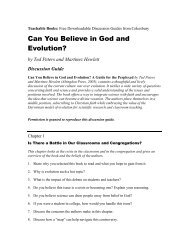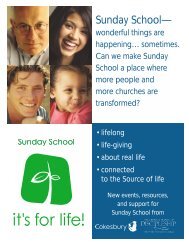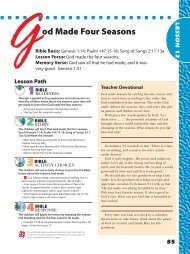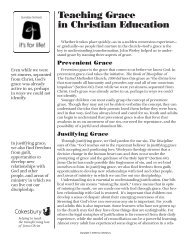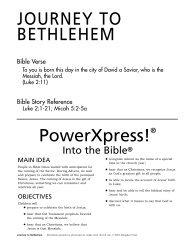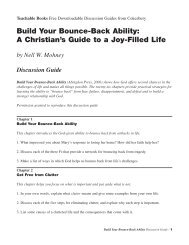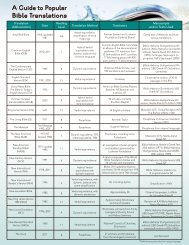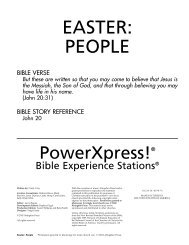Yearbook of American and Canadian Churches 2010 - Cokesbury
Yearbook of American and Canadian Churches 2010 - Cokesbury
Yearbook of American and Canadian Churches 2010 - Cokesbury
You also want an ePaper? Increase the reach of your titles
YUMPU automatically turns print PDFs into web optimized ePapers that Google loves.
Table 1—Longitudinal Inclusive Membership<br />
This table represents a longitudinal view <strong>of</strong> aggregated membership totals for all<br />
churches reporting to the <strong>Yearbook</strong>. These data do not reflect the entirety <strong>of</strong> national<br />
church membership since some churches either do not gather such data, or do not report<br />
them to the <strong>Yearbook</strong>. These figures moreover do not include membership <strong>of</strong> independent<br />
congregations including megachurches. Substantial numbers <strong>of</strong> church members, therefore,<br />
are not accounted for in nationally-gathered membership data. With more than 163<br />
million adherents, the churches collectively continue to maintain a substantial organizational<br />
<strong>and</strong> institutional presence within the United States.<br />
Table 2—US Membership Church Ranking<br />
This table allows comparison in size as determined by membership <strong>of</strong> the largest<br />
twenty-five churches in the nation. Dwarfing any single other church is the Catholic<br />
Church, reporting over 68 million adherents. The Church <strong>of</strong> Jesus Christ <strong>of</strong> Latter-day<br />
Saints is ranked 4th with nearly 6 million members. The remainder <strong>of</strong> the top 25 are<br />
Protestant <strong>Churches</strong> with two exceptions; the Greek Orthodox Archdiocese, which is<br />
ranked 17th, <strong>and</strong> the Jehovah’s Witnesses, which is ranked 22nd, displacing the United<br />
Church <strong>of</strong> Christ in this position.<br />
The patterns <strong>of</strong> affiliation reflected in this table <strong>of</strong>fer a numerical view <strong>and</strong> summary<br />
<strong>of</strong> <strong>American</strong> church history. Protestantism has, since the founding <strong>of</strong> the republic <strong>and</strong><br />
until the present moment, enjoyed cultural hegemony accompanied throughout by a<br />
consistent substantial Catholic presence.<br />
Four <strong>of</strong> the twenty-five largest churches are Pentecostal in belief <strong>and</strong> practice. Strong<br />
figures from the Assemblies <strong>of</strong> God <strong>and</strong> the Church <strong>of</strong> God (Clevel<strong>and</strong>, Tennessee) suggest<br />
a continuing increase in numbers <strong>of</strong> adherents to Pentecostal groups, though it is<br />
impossible to state unequivocally from this table since the other two charismatic<br />
churches in this ranking have not reported in some years. The four largest Pentecostal<br />
churches are: The Church <strong>of</strong> God in Christ, Assemblies <strong>of</strong> God, the Pentecostal<br />
Assemblies <strong>of</strong> the World, Inc., <strong>and</strong> the Church <strong>of</strong> God (Clevel<strong>and</strong>, Tennessee), which<br />
has moved from 25th to 24th in this ranking.<br />
The ranking <strong>of</strong> churches on the basis <strong>of</strong> membership remains relatively stable as indicated<br />
by the first column <strong>of</strong> numbers in Table 2. The last column presents increases<br />
(decreases) as a percentage change from the 77th edition’s reported membership figures.<br />
With the exception <strong>of</strong> the Catholic Church, United Church <strong>of</strong> Christ, the <strong>American</strong><br />
Baptist <strong>Churches</strong>, <strong>and</strong> The Episcopal Church, the largest 25 churches are maintaining<br />
respective growth (or decline) in membership. The largest percentage change was<br />
reported by the United Church <strong>of</strong> Christ, which diminished its rate <strong>of</strong> loss from -6.01%<br />
to -2.93%. The Catholic Church reversed from a one-year decline <strong>of</strong> 0.59% to post an<br />
increase <strong>of</strong> 1.49%. The Episcopal Church reports a 2.81% decrease in membership,<br />
quickening its losses from its previous -1.76% rate <strong>of</strong> decline reported in the 2009 edition<br />
<strong>of</strong> the <strong>Yearbook</strong>, but reflecting a slower decline in membership than the 4.15%,<br />
decline reported in the 2007 edition. The <strong>American</strong> Baptist <strong>Churches</strong> in the U.S.A. doubled<br />
its rate <strong>of</strong> membership decline, going from -0.94% to -2.00%.<br />
The top fifteen churches, those with membership exceeding two million members, are<br />
reflective <strong>of</strong> the constancy <strong>of</strong> the Historic Black <strong>Churches</strong>. Six <strong>of</strong> the fifteen largest<br />
churches (The Church <strong>of</strong> God in Christ, National Baptist Convention USA, National<br />
Baptist Church <strong>of</strong> America Inc., National Missionary Baptist Convention <strong>of</strong> America,<br />
Progressive National Baptist Convention, <strong>and</strong> African Methodist Episcopal Church) are<br />
predominately African <strong>American</strong> churches. This <strong>of</strong> course is reflective <strong>of</strong> the historic<br />
strength <strong>of</strong> the church within the African <strong>American</strong> community.<br />
In the last quarter century there has been much analysis <strong>and</strong> debate concerning the<br />
decline <strong>of</strong> “mainline” Protestantism. Whatever the specific rates <strong>of</strong> growth or decline<br />
may be for individual mainline denominations, this ranking illustrates a significant<br />
aggregate presence in the <strong>American</strong> religious l<strong>and</strong>scape. Of the top ten largest churches,<br />
three are mainline protestant (United Methodist, Evangelical Lutheran Church in<br />
America, <strong>and</strong> Presbyterian Church (U.S.A.)). In the top twenty-five churches, six are<br />
TRENDS &<br />
DEVELOPMENTS, 2009<br />
11



